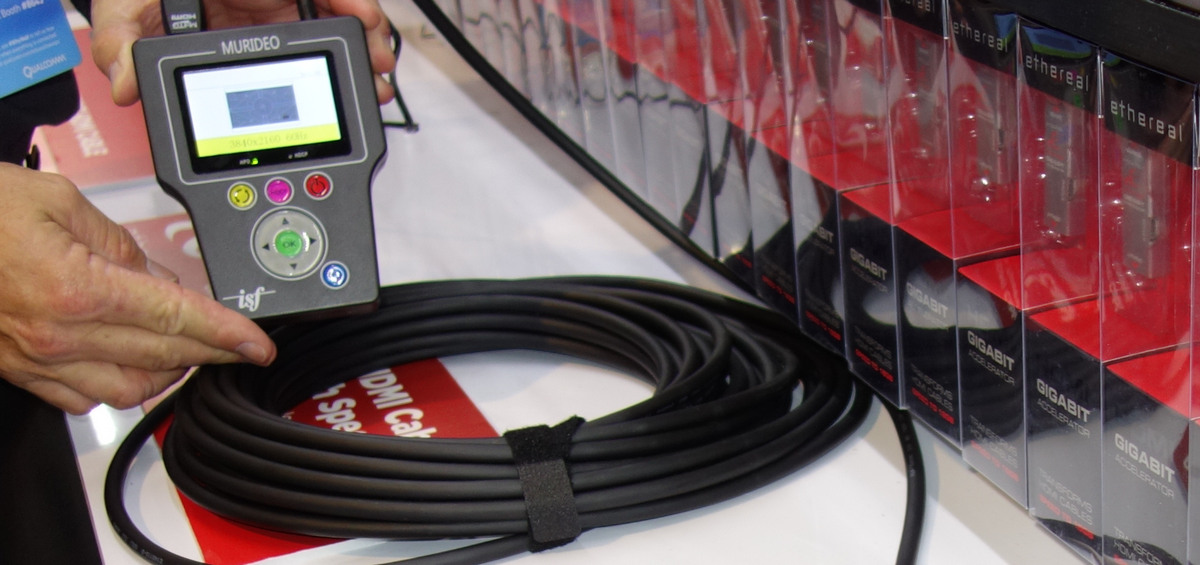Fred Harding, Brent McCall: Tips, Tools and the Current State of 4K Ultra HD
Friday, March 4, 2016 7:40:35 PM America/New_York
Two industry technical sales pros outline key considerations for 4K Ultra HD, including HDBaseT, HDMI® 2.0, HDCP 2.2, high dynamic range (HDR) and some problem–solving tips and tools.

Fred Harding and Brent McCall — March 4, 2016
4K, UHD, HDCP 2.2, HDMI 2.0, HDR, HDBaseT … It’s complicated. Two of the industry’s most popular techies — Fred Harding of Capitol Sales and Brent McCall of Metra Home Theater — lay it all out for integrators, highlighting the benefits of 4K–related technologies and the challenges of creating an end–to–end UHD experience for the consumer.
Fred and Brent wanted to keep this piece free from product ads, but since CE Pro feels it’s important to talk about specific products where warranted, with Fred’s permission we have inserted them into the story. As always, we thank Fred and Brent for their contributions. – CE Pro
THE NEXT BIG THING IN THE WORLD OF VIDEO is Ultra High Definition video, aka 4K. The concept is simple – or at least it should be: essentially delivering four times the resolution as 1080p, a widely accepted standard for high definition television.
To implement a 4K signal, lots of things need to happen. First, the display needs to be capable of producing an image with 3,940 x 2,160 pixels. (For discussion purposes, we’ll refer to the device that the picture is seen on as the display; it could be a projector providing the image, or a flat or curved panel using LED, OLED, or some other technology.)
Then you’ll need to have a true 4K source. As of March 1, 2016 there are several products that will actually provide a true 4K, 4:4:4 HDR signal. There are also devices that take conventional HD sources and upconvert, or scale them, to the 4K resolution. Examples include up converting Blu–ray players from many manufacturers, as well as 4K televisions themselves.
There are no off–air broadcasts currently being offered in the 4K format at this time. Seeing as how upgrading to a new broadcast standard is very expensive, it seems unlikely that we’ll see that anytime soon.
Satellite service providers like DirecTV and Dish Network offer selected programming in 4K resolutions. Streaming service providers like Netflix, Vudu and Amazon are starting to gear up as well. Selected disc players, labeled UHD Blu–ray players, are starting to appear on the market. I’d suggest those are likely to be the most capable of the sources discussed. The drawback with any of them will be what programming will be available to actually watch, at least initially.
4K will also require a connection to work. Our old friend HDMI is the generally accepted connecting method currently, although early display samples used proprietary connections that we’ve not seen in general circulation.
HDMI passive cables can be the cable of choice for short runs, but for distances greater than 15 feet, the options dwindle. One solution that has proven to work is a high bandwidth repeater on a passive HDMI cable that is rated for 18 Gbps. Other options use fiber to achieve distances of up to 100 feet. Clearly, this is evolving technology.
So it should be simple, right? Get your 4K display, slap it up against the wall, use an HDMI cable to connect to the source and push play.
Or not.
HDCP Challenges
One issue that folks ask about is HDCP, or High Definition Copy Protection. Since high definition video sources have been around, we’ve seen several advances in that technology. 4K signals in their native format are using a new and improved version called HDCP 2.2. Here’s some of the fine print:
- HDCP 2.2 is not backwards compatible. Displays that are equipped with earlier iterations of HDCP will not support a 2.2 source. Since we’re talking about 4K displays, that may not be a big deal. Remember, however, that most installations by professionals involve some sort of AVR or processor/preamp, and compatibility becomes a larger issue.
- Related to the AVR is the idea of compatible inputs and outputs. Devices that are older than two years old likely won’t support HDCP 2.2. Newer devices may only have selected inputs and/or outputs that will support HDCP 2.2. It would behoove the installer to know these things before calling tech support. Inputs on displays may also have selected compatibility characteristics.
- HDCP 2.2 was designed to work with native 4K content. In other words, if a manufacturer takes a 1080p signal and upconverts it, it’s not native 4K, and therefore not subject to HDCP 2.2 restrictions.
- Cables don’t really care about HDCP 2.2. They do, however, care about being able to support the volume of information that 4K requires. You really should be using cabling that can support 18 Gbps throughput.
HDMI 2.0 and HDR
Another topic is HDMI 2.0 and 2.0A, which the good folks over at HDMI have developed as the standard to support 4K.
HDMI 2.0A supports HDR, or high dynamic range. Essentially, think about being able to see details in shadows and highlights. Dimly lit scenes today either give you details in shadows, but washed out highlights, or normal highlights and nothing in shadows.
The HDR capability dramatically improves that function, and the display needs to be able to support that technology that the source supplies. Note that the original source has to have information in either the highlight or the shadow for the picture to reveal those characteristics. (The new $999 PrismaHDR from Murideo claims to add HDR to standard content and fix HDR where it’s natively available.)
Remember when high definition television first appeared on the market? There were actually 18 different high definition formats potentially available, with progressive scan and interlaced signals in a variety of resolutions.
With 4K, there will also be several different types, depending on the frame rate. You’ll see numbers like 24, 30 and 60 attached to those specifications. Additional considerations include color depth, typically measured as 8 bit or 10 bit. At some point, you will see a specification labeled 2160p60 4:4:4, today’s gold standard for 4K.
These specifications and improvements require a much broader bandwidth every step through the component chain. Your source will need to have 4K capability, of course, and have the ability to work with the HDCP 2.2 copy protection standard.
If it doesn’t, you’ll need an aftermarket inline box to insert that information onto the signal path so the display will play the source. (Key Digital and Zigen have some problem solvers).
Cabling will need to support 4K, and greater distances will clearly cause even greater problems.
With 1080p resolution, the market has settled on HDBaseT and twisted pair cabling.
Frankly, it’s been reliable, with capabilities of up to 330 feet available with selected models. The challenge with 4K and twisted pair cabling is, again, bandwidth.
If you want to use one of the many vendors offering extenders marketed as supporting 4K, you’ll get a device that delivers the pixels. What you will find, however, is that the Chroma portion of the signal will be compressed somewhat, and so all of the potential colors in the spectrum that 4K is capable of delivering won’t necessarily pass through.
At the recent ISE show in Amsterdam, the solution being put forth was to run two twisted pair cables in order to support the requisite resolution, color, and dynamics required for premium 4K deployment. Note that this was a working prototype, and not likely to be available on the market anytime soon.
The AVR or matrix switch mechanism you deploy will need to support the signal, of course, and not all of those that purport to do that will indeed work. It’s not that the manufacturer is a bad guy; it’s just that formats have evolved quickly, and older legacy devices might not work.
Bandwidth Issues
Add to that the reality that there aren’t a ton of sources available to deliver 4K product. The folks at Roku just started delivering their model Roku 4, which is capable of delivering 4K product streamed from Netflix, Amazon and other sources.
Connect it to the internet and you should have 4K, right? The challenge is that you need to have a robust Internet service provider to deliver the required bandwidth to provide a 4K signal. The bottleneck is that broadcast–grade encoders, which convert the signal from 4K video to a network stream, require in the neighborhood of 15 Mbps. Since the content is so dense, a larger buffer mechanism would likely make sense in the device, so that uninterrupted playback can occur.
The challenge is exacerbated when you consider that there are lots of devices in a residence competing for that bandwidth as it comes in the premise. You’ve got lots of things that potentially can make the streamed signal mess up, including IP cameras, SIP phones, little Johnny’s video game, mom’s Skype conversation with her sister, and more. (If you don’t have Fing as a utility on your iPad, you should. It allows you to survey a network for connected devices.)
Further, depending on the ISP, your neighbor’s activities may also impact your speed; the cliché about network speed dropping when school lets out has some truth to it. Adding to that, imagine the potential bottleneck when lots of people want to stream the same content simultaneously.
As the installer, it’s clearly in your best interest to let your customers know about the issues before you install this technology. Otherwise, your phone will be ringing at all hours with unhappy folks at the other end of the line. Installers who are doing larger projects should consider purchasing a 4K testing device (for example Murideo), which will allow the user to check for HDCP compliance, resolution, Chroma, audio, geometry, motion artifacting and more.
Does 4K Content Really Matter?
Will your customer be able to discern a 4K image? The best answer is: It depends.
The combination of size of image and closeness to the display will, in part, determine whether the increased detail will be apparent to the viewer. If you take a look at a 1080p image with your nose next to the display, you’ll see pixels that just aren’t discernable in 4K content. That’s one reason why manufacturers today aren’t making 4K displays smaller than 40” or so.
You will be able to see the difference that HDR makes, regardless of proximity to that image, provided the information is present on the original source.
Information for this article was supplied, in part, by Mike Tsinberg at Key Digital, Brent McCall at Metra Home Theater/Ethereal, Matt Murray at Murideo, Cheryl Johnson at Capitol Sales, and Andrew Turner at Sony Corporation. Any errors are the responsibility of the author.
Click here for the original article.










